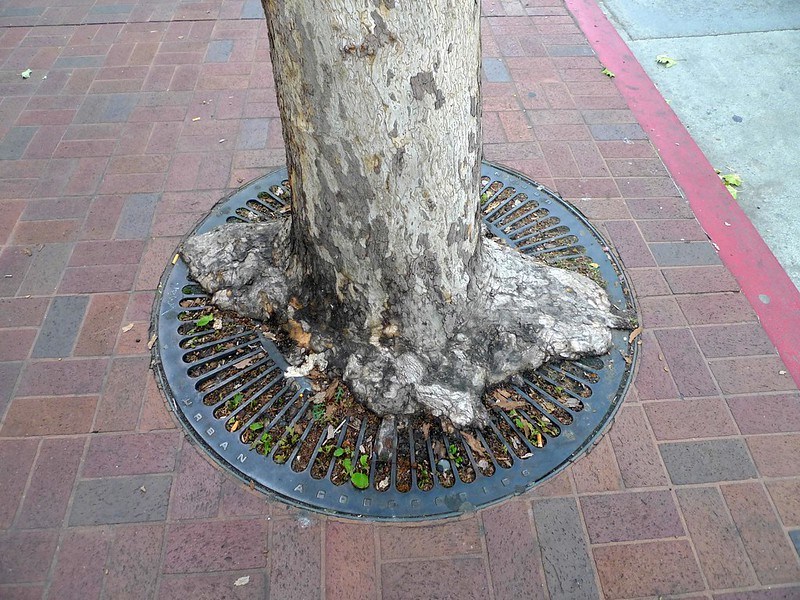Trees survive better in a natural forest environment and woodland areas. However, in urban settings, trees have to deal with unfavorable conditions such as paved surrounds, rising microclimate temperatures, air pollution, and lack of water, damage or removal during the construction of nearby sidewalks, and physical damage by vehicles among other challenges. Tree grates offer protection against some of these severe conditions.
Why Use Tree Grates?
First, urban areas feature a high population of people who walk or park next to trees. These grates cover the soil surrounding the tree, preventing soil compaction. They also offer shade to the ground covering tree roots, reducing water evaporation. During summer and drought seasons, this feature is a definite advantage.
Most tree grates are appealing aesthetically. Like many urban developers, you may have a hard time when choosing the tree species that will blend with urban landscapes and grow naturally as well. The good news is that you can use grates around the trees to make them appealing and noticeable. With a reasonable budget, you can purchase those with lights installed.
High-quality tree grates allow air, water, and debris through the grills. excess waste inside the pit should be removed regularly; it can hinder the flow of water and soil or cause soil buildup on the trunk. Grates also protect tree roots against exposure to extremely high temperatures promoting healthy tree growth.
Tree grates can be used together with tree watering grates. They are installed along curb lines andallow water to flow to tree pits. The water then flows and serves all trees on the street via underground watering systems. This feature makes water filtration possible and lowers watering costs. This approach is quite efficient since trees filter and absorb storm water, naturally reducing the threat of combined sewer overflows.
After installation, most tree grates are never removed. But sometimes tree roots outgrow the ring, calling for a replacement or complete removal. Otherwise, the roots will grow upwards rather than outward. Without regular pruning or a proper root barrier, the growing roots can damage sidewalks.
Installing Tree Grates
Before you install tree grates into an urban setting, there are several thing things that you should consider. Some of them include:
- Vehicle Traffic: If vehicles are going to move in and out of the space, you intend to install the tree grates, ensure that you use a material that can withstand the weight. Concrete tree grates or massive metal grills would come in handy in such a situation.
- Existing landscape design: Before choosing the design or grate material to use, decide whether you want to change, improve, or ignore the current look of the environment.
- Availability: This will influence the material or design of the tree grates you use. Some materials may not be locally available, adding extra expenses on transportation.
- Disabled friendly: You need to choose a treegrate design with patterns and slits that are ideal for wheelchair wheels.
- Personal preference: In the long run, aesthetic choices and personal taste or clients’ preferences determine the kind of grates you end up installing. Options range from metal, stone, plastic to cast iron tree gates.
Another factor that you may need to consider is the amount of soil below the grate. Before installation, you should determine whether the soil is enough for healthy tree growth. There should be sufficient space for the tree roots to grow outward. Usually, if the area is limited, longevity, and growth of the tree, people’s safety and beauty of the surroundings will be compromised.
Wondering how much space you should save for the roots? The answer varies and highly depends on the tree species. Most trees with a 20 feet canopy diameter require 20 feet by 10 feet by 3 feet deep pit. Smaller trees can grow comfortably in 4 feet by 4 feet by 4 feet deep hole.
Expandable Tree Grate Openings
Tree grates are available in different shapes and sizes. They are also designed to accommodate all stages of your tree growth. Like most plants, the size of tree trunks changes over the years. Adjustable tree gates protect trees throughout their lifespan and keep your landscape beautiful for decades.
You can replace or remove the center ring of the tree grate as your tree trunk grows-this calls for proper planning before the installation. The adjustable rings also allow easy cleaning and maintenance of the pit. Ensure that you purchase a grate with at least one ring.
Final Thoughts
Trees in urban areas help to purify the air by absorbing harmful carbon dioxide. They eliminate pollutants such as nitrogen oxides, carbon monoxide, Sulphur dioxide, and cadmium to improve the well-being and health of urban residents. It’s hard to ignore the fact that trees add beauty and a taste of nature to the landscape. Although maintaining trees in this environment is challenging, tree grating makes everything possible.


